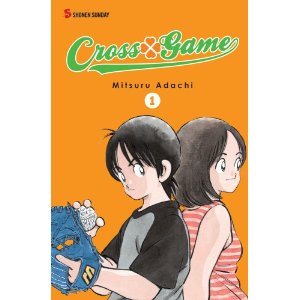Itazura Na Kiss Volume 3 by Kaoru Tada
The third volume of this delightful shoujo series opens with Kotoko and tennis club captain Sudou spying on the objects of their affection Irie and Reiko when they go out on a date. The hapless pair trail the dating couple to a showing of Edward Scissorhands. In the meantime Kotoko’s self appointed future husband Kinnosuke attempts to follow Kotoko and ends up in a porno movie theater. In one of Tada’s cute bits of character interaction, Kotoko and Sudou are destroyed with emotion by the ending of the movie, while Irie calmly proclaims that he wants to make an artificial being one day. Irie knows that he’s being tailed and ends the date, spending the rest of the day with Kotoko after telling her that her reactions to his date were hilarious. Irie announces that his life use to be boring and uneventful, with noting but trouble appearing since Kotoko came into his house. He says that she’s a trial he has to test himself against, but he doesn’t mind her being around. This is the closest thing to a declaration of affection that Irie is capable of, and Kotoko is delighted.
Later, there’s a school festival where the anime club has adopted Kotoko as their main character in an anime “Racquet Warrior Kotorin”. Kotoku ends up beating out Reiko for the title of school festival queen due to the powerful otaku voting lobby. One of things I like about this series is the large and funny ensemble cast. Irie’s mom makes a point of exclaiming over Kotoko’s skin when both families go on a hot springs vacation, very aware that her son will be able to overhear her. Kinnosuke and Sudou’s hapless attempts to court the objects of their affection continue to amuse, and it is hard not to root for Kotoko’s desired romance with Irie.
Alice the 101st Volume 2 by Chigusa Kawaii
As the volume opens Aristide Lang aka Alice is dismayed to discover that Max, the best violinist in his class is a bit of a space case. Alice’s mentor and fellow classmate Victor directed him to view Max as his rival, and Alice freaks out when the genius violinist actually seems a bit goofy. Alice has prodigious musical gifts that are hampered by his extreme ignorance. Alice has perfect pitch and can play almost any piece by ear, but he is utterly incapable of reading a musical score. He’s bullied by other students who don’t understand why he was admitted to their school as a special case. Alice’s violin teacher sets him the task of playing Twinkle Twinkle Little Star “exactly as it is written,” and Alice doesn’t know who to go to for help. All of his friends are busy practicing for the upcoming concert. He ends up stumbling across Max and asks him for help.
This volume deals with issues of musical interpretation and accompaniment. While Alice can reproduce a piece of music when he’s heard it once, he isn’t sure how to answer when his classmate Georges plays Motzart’s version of song and asks Alice what his own version of the piece sounds like. Max is able to display an amazing degree of technical proficiency with a piece by Bruch, but does Alice’s innate ability to produce a more interesting tone mean that he’ll eventually be able to surpass his rival? There were plenty of amusing moments in this second volume as Alice continues to overreact to everything around him, but I continue to enjoy the way Kawaii is able to portray the process of learning how to make music.
Access to electronic copies provided by the publisher.


